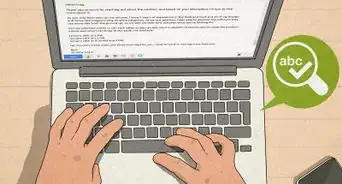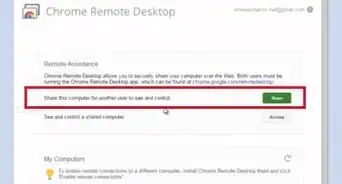This article was written by Jennifer Mueller, JD. Jennifer Mueller is an in-house legal expert at wikiHow. Jennifer reviews, fact-checks, and evaluates wikiHow's legal content to ensure thoroughness and accuracy. She received her JD from Indiana University Maurer School of Law in 2006.
There are 14 references cited in this article, which can be found at the bottom of the page.
This article has been viewed 69,298 times.
When hiring a new employee, getting proof of past employment may be one of the most important things you can do to help ensure you're hiring someone who has the knowledge and experience necessary to do the job. At the same time, it's one of the easiest things for candidates to lie about on resumés and job applications. Fortunately, there are ways you can verify a candidate's job history so you know the person you're hiring is just as promising in person as he or she is on paper.[1]
Steps
Using a Verification Service
-
1Decide what information you need. Which service works best for you may depend on the specific details you need to prove for a particular candidate.
- Services can confirm the start and end dates of the candidate's previous jobs, the titles and duties of those jobs, as well as salary figures. In some states, you also can learn about the reason for the employee's termination and whether the company considers him or her eligible for rehire.[2]
- The law regarding what former employers can disclose varies widely among states, so it's worth checking your state's law if you think verifying the candidate's previous job performance, professional conduct, or reasons for termination are important.[3]
-
2Determine how far back you want to go. Typically employers want to verify either a certain number of previous employers or employment for a certain number of years.
- The way you want to define this depends not only on your company's needs but the work history of the candidate. For example, if someone applies to work for you who has been working for the same employer for six years, an employment verification that went back five years would only capture that one job.
- Many employers favor the approach of reviewing a candidate's past five years of work history or last two employers, whichever is longer.[4]
- Keep in mind that some applicants may have gaps in their employment history that would cause difficulty if you went with a strictly years-based approach.[5] For example, if you were reviewing the past five years, but the applicant was out of work for two years giving birth and taking care of an infant, your five years would only capture three years of work.
Advertisement -
3Choose a verification service. Based on your assessment of your needs, you can find a verification service that will deliver the information you need the most efficiently and cost-effectively.
- Not only are there different verification services that have access to different databases and information, but each service may have several different options from which you can choose the one that best suits your company.
- For example, Equifax provides employment verifications through its service, The Work Number. These services vary in price depending on whether you need salary information or simply need to confirm where the candidate worked and how long he or she worked there.
-
4Get consent from the employee candidate. Your verification service probably will require a signed consent document before it completes the search. [6]
- In some states such as Delaware and Oklahoma, consent from the candidate is required by law if you want to contact former employers or look into his or her employment history.[7]
- If you're looking for work, you can sign up with verification services yourself and offer a code for employers to verify your employment history. Having this option available can not only make the hiring process quicker and smoother, but also will increase a potential employer's confidence in you as a new hire.[8]
-
5Receive the verification report. Within a few days or a week, the service will send you a report of its findings.[9]
- Once you receive the report, you may want to compare it with the candidate's application or resumé and assess the validity of the information you were provided.
-
6Meet with the candidate. You may want to give the candidate an opportunity to explain any discrepancies between the verification report you received and the information he or she supplied to you.
- Typically the verification company also must give the applicant the opportunity to dispute any information contained in the report if he or she contends it isn't accurate. Find out the procedures from your verification company and inform the applicant as needed.[10]
- In some cases, discrepancies may be the result of a misunderstanding. For example, if the applicant was placed with an employer through a temp agency and then hired full time, he may simply list the name of the company for the entire period of employment, even though initially he was not on the company's payroll. This would cause a discrepancy between the verification service's report and the information he gave you.[11]
Getting a Background Check
-
1Decide what information you want included. Depending on the needs of your business and the responsibilities of your employees, you may need to review different aspects of a candidate's background apart from verification of his or her employment history.
- The scope and depth of your background check should reflect the nature of the position for which the candidate is applying.[12] For example, if the job entails no financial responsibilities or handling of cash transactions, you probably don't need to pull an applicant's credit report. Likewise, there's no reason to look at a candidate's driving record if his or her job duties won't entail driving for the company (not including the commute to the workplace).
-
2Choose a background check service that meets your needs. Among the many different background check services, the best for you will be the one that provides all the information you want and doesn't waste your time or money pulling information about employee candidates that isn't necessary for you to evaluate that candidate's viability with your company.
- For example, some companies verify an applicant's education records and driving records, but if you don't need this information, you can save time and money by not requesting it.[13]
- Make sure the service you choose is in compliance with its responsibilities under the federal Fair Credit Reporting Act (FCRA). The law mandates specific procedures for providing notification to applicants and ensuring all reported information is accurate and up to date.[14]
-
3Get consent from the employee candidate. You must obtain consent before you can conduct a background check on a potential employee.
- Federal law requires you to inform the candidate that you are conducting a background check, as well as explaining that the information you obtain through the background check may be used in deciding whether to hire him or her.[15]
- The law also requires you to have written consent from the employee before any background checks are performed. The scope of the background check should be generally explained in the document the employee signs authorizing the check and report.[16]
- If you're getting a full investigative report, which can include interviews with people who know the applicant, you also must inform the applicant that he or she has the right to a full description of the scope of the investigation and the types of questions that will be asked.[17]
-
4Receive the results of the background check. The background check service will provide you a report of the results of the completed background check.
- Keep in mind that federal law prohibits using this information to discriminate against applicants on the basis of certain traits such as race, sex, religion, or disability. Make sure you're using the information appropriately, and that any information on which you base your decision is directly related to the job and necessary for you to run your business.[18]
- Under federal law, you must securely dispose of any background report you receive after one year, regardless of whether the applicant is hired.[19]
-
5Follow up with the employee candidate. If the information in the background check raises questions, you may need to discuss these with the potential employee and resolve any discrepancies.
- In many cases, a discrepancy may be due to a misunderstanding rather than any intent on the part of the applicant to mislead you about his or her past.
- In some circumstances, it also may be helpful to get the employee's story behind what happened or what led to a particular entry on their background check.
- If you decide not to hire the applicant based on information contained in the background report you received, you must provide him or her with a written statement specifying the information that led to your decision along with a copy of the report you received.[20]
Requesting Pay Stubs and Tax Records
-
1Check state law to determine what you can request. Although many employers request that employees provide copies of W2s or tax returns to verify employment, these forms may need to be redacted to remove certain sensitive or potentially discriminatory information.
- At a minimum, you probably should request applicants redact their Social Security numbers from these documents.[21]
- You also should be aware that these documents may contain information about sick pay or benefits that would indicate the applicant is in a class protected by federal anti-discrimination laws. Some states such as California have laws that prohibit employers from even asking questions regarding this type of information, so you may want to ask that applicants black out that information as well.[22]
-
2Request the appropriate documents from the employee candidate. Most employers make the employee responsible for providing tax or Social Security documents as proof of employment.
- Keep in mind that even if an applicant refuses to allow you to contact a previous employer, you still can ask for documents such as W2s to verify their income and the years they were employed.[23]
- Tax or Social Security documents also can be an important way to verify employment if the previous employer has gone out of business and you have no way to get in touch with them to verify the employment.[24]
- If applicants don't have copies of their W2s, they can order a transcript from the IRS for the years you need proof of employment. Transcripts for the current year and past three years the applicant has filed taxes are available online or by calling 1-800-908-9946.[25] <ref.https://www.irs.gov/pub/irs-pdf/f4506t.pdf</ref>
- Applicants also can get certified yearly reports of earnings from the Social Security Administration. These certified reports cost $56 for each year requested, although non-certified yearly reports can be retrieved online for free.[26]
-
3Compare the information on the documents to the candidate's resume or application. Once the potential employee has submitted the documentation you requested, you can see if it matches the self-reported information.
- Keep in mind that tax or Social Security documents only provide basic information about employment, such as the dates the person was employed and the income he or she received.
- If the applicant had any contract or temporary work, the name of the employer listed on the W2 or another document may differ from that he or she listed on the application. In that case, you typically will need to call the temp agency or another service the applicant used to verify where the applicant was placed.[27]
-
4Contact previous employers as necessary. If any discrepancies appear, you may want to get the story straight from the employer who worked with your candidate.
- Rather than using the contact information your employee provided on their application or resumé, you might want to do an interest search for the employer and find an official address. Keep in mind that the candidate may already have talked to a co-worker or other friend and asked them to provide a positive reference if asked, so it may be in your best interest to skip the information given to you by the applicant and go directly to the source.
- Mail a verification request to the human resources department or similar supervisor, and ask for written proof.[28]
- In most states, you are allowed to ask the dates of employment, job titles and duties the applicant had, and his or her rate of pay. In some states you also may ask about the applicant's performance and disciplinary record, as well as the reason his or her employment ended.[29] [30]
-
5Follow up with the employee candidate. Once you've finished your review, let the potential employee know the outcome and any decision you've made based on the information provided.
- You also might consider letting the applicant know what will be done with his or her sensitive information and how these documents will be kept secure. Keep in mind that federal law and EEOC regulations require you to destroy any such documents after a year.[31]
References
- ↑ http://www.hireright.com/blog/2015/03/employment-verification-a-crucial-check/
- ↑ http://www.hireright.com/blog/2015/03/employment-verification-a-crucial-check/
- ↑ http://www.nolo.com/legal-encyclopedia/free-books/employee-rights-book/chapter9-6.html
- ↑ http://www.hireright.com/blog/2015/03/employment-verification-a-crucial-check/
- ↑ http://www.hireright.com/blog/2015/03/employment-verification-a-crucial-check/
- ↑ http://www.hireright.com/blog/2015/03/employment-verification-a-crucial-check/
- ↑ http://www.nolo.com/legal-encyclopedia/free-books/employee-rights-book/chapter9-6.html
- ↑ http://www.verifyx.com/employees.aspx
- ↑ http://www.precisehire.com/employment-verification.html
- ↑ http://www.eeoc.gov/eeoc/publications/background_checks_employers.cfm
- ↑ http://www.precheck.com/blog/employment-verification-best-practices-verifying-employment-history-temporary-worker
- ↑ http://www.hireright.com/blog/2014/02/4-best-practices-for-thorough-criminal-and-public-record-checks/
- ↑ http://www.today.com/id/4018280/ns/today-today_news/t/most-firms-now-use-background-checks/#.VkjAuoQzDGk
- ↑ http://www.hireright.com/blog/2013/01/does-your-background-check-company-comply-with-3-key-provisions-of-the-fcra/
- ↑ http://www.eeoc.gov/eeoc/publications/background_checks_employers.cfm
- ↑ http://www.eeoc.gov/eeoc/publications/background_checks_employers.cfm
- ↑ http://www.eeoc.gov/eeoc/publications/background_checks_employers.cfm
- ↑ http://www.eeoc.gov/eeoc/publications/background_checks_employers.cfm
- ↑ http://www.eeoc.gov/eeoc/publications/background_checks_employers.cfm
- ↑ http://www.eeoc.gov/eeoc/publications/background_checks_employers.cfm
- ↑ http://www.sfgate.com/business/networth/article/Employers-asking-job-seekers-for-W-2-or-tax-return-3530180.php
- ↑ http://www.sfgate.com/business/networth/article/Employers-asking-job-seekers-for-W-2-or-tax-return-3530180.php
- ↑ http://www.hireright.com/blog/2015/03/employment-verification-a-crucial-check/
- ↑ http://www.hireright.com/blog/2015/03/employment-verification-a-crucial-check/
- ↑ https://www.irs.gov/uac/Newsroom/Request-a-Transcript-or-Copy-of-a-Prior-Year-Tax-Return
- ↑ https://www.ssa.gov/forms/ssa-7050.pdf
- ↑ http://www.precheck.com/blog/employment-verification-best-practices-verifying-employment-history-temporary-worker
- ↑ http://www.entrepreneur.com/answer/221063
- ↑ http://www.csun.edu/careers/verifying-employment-historyconducting-reference-checks
- ↑ http://www.nolo.com/legal-encyclopedia/free-books/employee-rights-book/chapter9-6.html
- ↑ http://www.eeoc.gov/eeoc/publications/background_checks_employers.cfm
About This Article
If you’re trying to verify someone’s employment, there are a few ways you can get proof. The easiest way is to ask for a pay stub or a tax record from the person to prove that they work at a certain place. Alternatively, you could contact their employer directly to confirm that they work there. You could also use a verification service, like through Equifax, to verify someone's income. Once you’ve chosen a verification service, you’ll need to get signed consent from the person. Verification reports usually take a few days to a week to come back. To learn how to use a background check to verify employment, read on!











































































